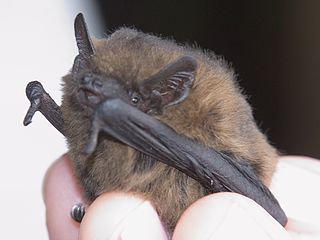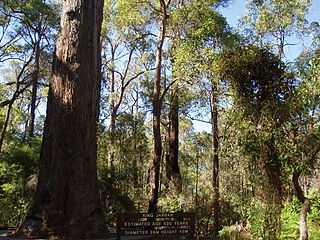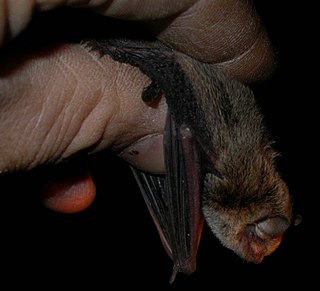
Eucalyptus marginata, commonly known as jarrah, djarraly in Noongar language and historically as Swan River mahogany, is a plant in the myrtle family, Myrtaceae and is endemic to the south-west of Western Australia. It is a tree with rough, fibrous bark, leaves with a distinct midvein, white flowers and relatively large, more or less spherical fruit. Its hard, dense timber is insect resistant although the tree is susceptible to dieback. The timber has been utilised for cabinet-making, flooring and railway sleepers.

Vespertilionidae is a family of microbats, of the order Chiroptera, flying, insect-eating mammals variously described as the common, vesper, or simple nosed bats. The vespertilionid family is the most diverse and widely distributed of bat families, specialised in many forms to occupy a range of habitats and ecological circumstances, and it is frequently observed or the subject of research. The facial features of the species are often simple, as they mainly rely on vocally emitted echolocation. The tails of the species are enclosed by the lower flight membranes between the legs. Over 300 species are distributed all over the world, on every continent except Antarctica. It owes its name to the genus Vespertilio, which takes its name from a word for bat, vespertilio, derived from the Latin term vesper meaning 'evening'; they are termed "evening bats" and were once referred to as "evening birds".
Barakee is a national park in New South Wales, Australia, 257 km north of Sydney. It is connected to Barakee State Conservation Area.

Pipistrellus is a genus of bats in the family Vespertilionidae and subfamily Vespertilioninae. The name of the genus is derived from the Italian word pipistrello, meaning "bat".

The common pipistrelle is a small pipistrelle microbat whose very large range extends across most of Europe, North Africa, South Asia, and may extend into Korea. It is one of the most common bat species in the British Isles. In Europe, the northernmost confirmed records are from southern Finland near 60°N.

Nathusius' pipistrelle is a small bat in the genus Pipistrellus. It is very similar to the common pipistrelle and has been overlooked in many areas until recently but it is widely distributed across Europe. It was described by two German naturalists, Alexander Keyserling and Johann Heinrich Blasius, and named by them after Hermann von Nathusius, in gratitude for his support of their research.

Jarrah Forest, also known as the Southwest Australia woodlands, is an interim Australian bioregion and ecoregion located in the south west of Western Australia. The name of the bioregion refers to the region's dominant plant community, jarrah forest – a tall, open forest in which the dominant overstory tree is jarrah.

Rüppell's or the greater broad-nosed bat is a species of vespertilionid microbat found in eastern Australia.
The eastern false pipistrelle is a vesper bat that occurs in eastern and south-eastern Australia, including the island of Tasmania.
The yellow-lipped cave bat is a vesper bat that only occurs in the Kimberley region of northwest Australia. The bat was first captured at Tunnel Creek in 1958 and a description published nearly twenty years later. Aside from observations of their physical characteristics, a preference for caves, and hunting insects over streams, little is known of the species.
The southern forest bat is a vesper bat found in Australia.

The little forest bat is a species of vesper bat in the family Vespertilionidae. It is found only in south-eastern Australia, including Tasmania. It is a tiny bat often weighing less than 4 g (0.14 oz). It is sometimes referred to as Australia's smallest mammal, although the Northern or Koopmans Pipistrelle, Pipistrellus westralis, is possibly smaller, weighing on average around 3 g (0.11 oz). It is the smallest bat in Tasmania
Falsistrellus is a genus of vespertilionid family of bats, small predatory flying mammals. They are known from Australia. The poorly researched species have been variously placed by authors, and revised again by studies of their distinct characteristics, consequently the falsistrelles may also be referred to as pipistrelles or false pipstrelles.

The Vespertilioninae are a subfamily of vesper bats from the family Vespertilionidae.

The Christmas Island pipistrelle is an extinct species of vesper bat that was found only on Christmas Island, Australia.The last individual bat seen in August 2009 with no further sightings despite intensive efforts to locate it.

Pipistrellus raceyi, also known as Racey's pipistrelle, is a bat from Madagascar, in the genus Pipistrellus. Although unidentified species of Pipistrellus had been previously reported from Madagascar since the 1990s, P. raceyi was not formally named until 2006. It is apparently most closely related to the Asian species P. endoi, P. paterculus, and P. abramus, and its ancestors probably reached Madagascar from Asia. P. raceyi has been recorded at four sites, two in the eastern and two in the western lowlands. In the east, it is found in open areas and has been found roosting in a building; in the west it occurs in dry forest. Because of uncertainties about its ecology, it is listed as "Data Deficient" on the IUCN Red List.
Bangadilly National Park is a national park located around 20 km west of Bowral in the Southern Highlands of New South Wales. Established in 2001, it is made up of three separate, similarly sized areas of land totalling 2,141 hectares in area. It consists of sandstone plateaus and gorges bordering the Wingecarribee River.

Nyctophilus major, referred to as a western long-eared bat, is a species found in forests and woodlands of Southwest Australia.

Vespertilionini is a tribe of bats in the family Vespertilionidae. The largest of the tribes in Vespertilioninae, it contains many genera found throughout the Old World and Australasia.











